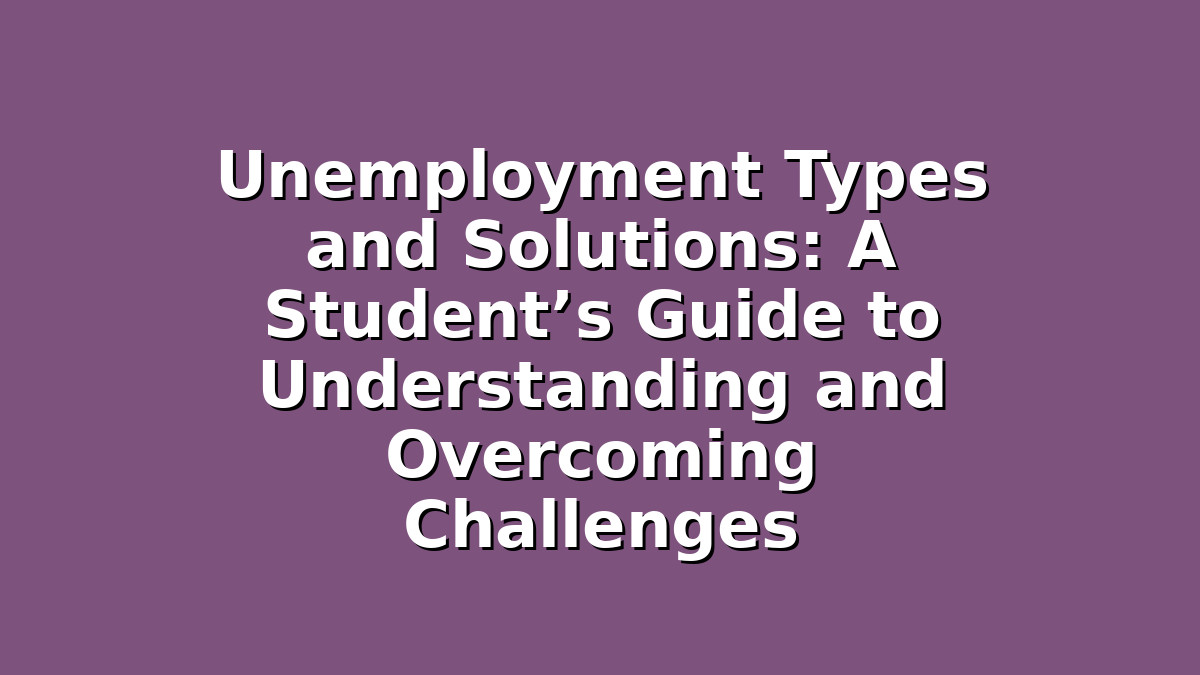Preparing for exams or focusing on your studies can be stressful enough without worrying about the job market. However, as a student, understanding unemployment—its types and possible solutions—not only broadens your knowledge but also equips you with insights to plan your future career smartly. Whether you’re studying economics, social studies, or simply want to be more informed, this guide will help you grasp the different types of unemployment and how solutions are developed to tackle them. Plus, we’ll share study tips that connect this information to your academic success.
Introduction
Unemployment is a common topic in economics and social sciences, but it can also feel overwhelming if you’re not sure where to start. Simply put, unemployment means people who are actively looking for work but cannot find jobs. But unemployment isn’t one-size-fits-all; it comes in different types, each caused by unique factors and each demanding different strategies to solve. For students preparing for exams, understanding these nuances can enhance your critical thinking, improve essay writing, and prepare you for real-world discussions on the economy.
In this article, we’ll explore three main types of unemployment: frictional, structural, and cyclical. For each, we’ll explain what it means, provide examples, and share study tips to help you remember and apply these concepts effectively.
—
1. Frictional Unemployment: The Temporary Gap
What is Frictional Unemployment?
Frictional unemployment happens when people are temporarily between jobs or are entering the workforce for the first time. It’s a natural part of a healthy economy because workers often take time to find the right job that fits their skills and preferences.
Example:
Imagine a student who has just graduated and is searching for their first job. During this period, they’re frictionally unemployed. Or consider someone who leaves one job to find a better one; the time in between counts as frictional unemployment.
Why should students care?
As students, you might soon experience this yourself. Understanding frictional unemployment can ease anxieties about job hunting after graduation. It’s normal not to find a perfect job immediately.
Study Tips:
– Make flashcards: Write down the definition, causes, and examples of frictional unemployment.
– Use real-life examples: Relate frictional unemployment to your own life or stories you’ve heard. This makes the topic more memorable.
– Practice explaining: Teach the concept to a friend or family member. Explaining ideas aloud reinforces your understanding.
—
2. Structural Unemployment: When Skills Don’t Match Jobs
What is Structural Unemployment?
Structural unemployment occurs when there’s a mismatch between the skills workers have and the skills employers need. This can happen because of technological changes, shifts in the economy, or geographical factors.
Example:
Think of a factory worker whose job is replaced by robots or automation. If they don’t have the skills to work with new technology, they may become structurally unemployed. Similarly, coal miners losing jobs due to a shift toward renewable energy face structural unemployment.
Why should students care?
As you plan your studies and career, knowing about structural unemployment helps you choose subjects and skills that are future-proof. It highlights the importance of continuous learning and adaptability in a changing job market.
Study Tips:
– Stay informed: Follow news about industries and emerging technologies to understand labor market trends.
– Connect with career guidance: Use resources at your school or university to identify which skills are in demand.
– Create mind maps: Organize information linking types of unemployment to causes and solutions. This visual aid can simplify complex topics.
—
3. Cyclical Unemployment: The Impact of Economic Ups and Downs
What is Cyclical Unemployment?
Cyclical unemployment happens when the economy slows down, like during a recession, and businesses cut back on hiring or lay off workers. It’s called “cyclical” because it follows the natural ups and downs of economic cycles.
Example:
During the COVID-19 pandemic, many businesses closed or reduced staff due to lower demand. This led to cyclical unemployment globally.
Why should students care?
Understanding cyclical unemployment can help students appreciate how broader economic factors affect jobs. This knowledge can also encourage resilience, knowing that economic downturns don’t last forever and that recovery often follows.
Study Tips:
– Relate to history: Learn about past recessions and recoveries to see cyclical unemployment in context.
– Use diagrams: Draw graphs showing economic cycles and unemployment rates. Visuals help retain complex data.
– Practice past paper questions: Many exams include questions about economic fluctuations. Practicing helps you apply theory effectively.
—
Conclusion: Turning Knowledge into Action
Unemployment might seem like a distant or daunting topic, but as students, understanding its types and solutions is crucial not just for exams but for your personal and professional growth. Frictional, structural, and cyclical unemployment each reveal different challenges in the job market, but they also point to ways we can prepare and adapt.
By studying these types carefully and using the provided tips—like making flashcards, connecting concepts to real life, and practicing exam questions—you’ll not only improve your academic performance but also build valuable life skills. Remember, the job market changes constantly, and your ability to learn and adapt is your greatest asset.
Keep a positive mindset, stay curious, and use what you learn about unemployment as a stepping stone to make informed career choices. Your future self will thank you!
—

Responses